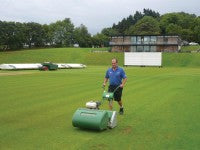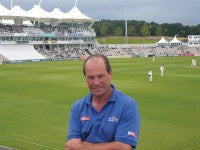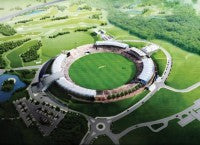Bowl'dly Going ...
 "Clubs should always produce the best pitches they can, with the focus on the strength of the players, not the weakness of the opposition"
"Clubs should always produce the best pitches they can, with the focus on the strength of the players, not the weakness of the opposition"
England's less than convincing defeat of the Australians to regain the Ashes was achieved amid some controversy, with groundstaff at Edgbaston and The Oval the target for a few moans from various quarters.
The condition of test wickets and outfields is coming under greater scrutiny than ever before as the England and Wales Cricket Board (ECB) pumps millions of pounds into drainage, irrigation and turf projects at cricket's showcases for the international game.
Nigel Gray, head groundsman at the Rose Bowl, the home of Hampshire County Cricket Club, is alert to the challenges faced by his counterparts in what is an increasingly high profile position - challenges he knows will be intensified as the club's Eastleigh headquarters undergoes a £45m sport and leisure redevelopment in its aim to become one of Britain's leading test match venues.
"The plan is to make the Rose Bowl the first modern test ground, under regulations set out by the ECB," states Nigel unequivocably, and he has good reason to talk in such bold terms, given that the site plans to stage its debut test in 2011.
Hampshire CCC is a club familiar with notable achievements in the game. It became the first PLC in English cricket when the category A Rose Bowl venue changed from a members-owned entity in 2001 under the leadership of chairman and chief executive Rod Bransgrove.
 The Rose Bowl complex, complete with the distinctive 'tented' main stand, boasts one of the largest playing areas in top-flight cricket, with facilities that include a fully-fledged nursery ground next to the stadium and three net areas.
The Rose Bowl complex, complete with the distinctive 'tented' main stand, boasts one of the largest playing areas in top-flight cricket, with facilities that include a fully-fledged nursery ground next to the stadium and three net areas.
Recalling the transformation in provision that took place when the club moved its base, Nigel says: "We wanted twenty pitches with a reasonable boundary, as those at Northlands Road were very tight. The new ground gives us 50-yard boundaries and the ability to play first-class cricket on every strip, so that means we no longer need to worry about the quality of others if we needed a back-up."
Space also allowed the development of a 9-hole golf course, complete with practice green, stretching across 125 acres adjacent to the nursery ground. However, the recent green light for redevelopment of the site clears the way for a new 18-hole course to replace it.
The philosophy behind the bowl shaped arena, designed by architect Sir Michael Hopkins, renowned for Portcullis House in Westminster, the new opera house at Glyndebourne and the Mound Stand at Lord's - was to make the cricket more intimate by striking a balance between adequate boundaries and keeping the crowd involved with the action, Nigel explains.
The scope of provision is also extensive. "We have the luxury of being able to offer more facilities while games are being played than all other clubs, with the exception of Lord's who are on a par with us," he states.
 Plans to move Hampshire CCC from the Northlands Road site were first raised in 1987 when committee members looked into building a second tier over the car park, only to discover that there were restrictions on any expansion of the 100-year old site.
Plans to move Hampshire CCC from the Northlands Road site were first raised in 1987 when committee members looked into building a second tier over the car park, only to discover that there were restrictions on any expansion of the 100-year old site.
By June 1988 committee members found a suitable alternative, forty acres at West End, owned by Queen's College, Oxford. The College offered the land on a 999-year lease and, in October 1988, Eastleigh Borough Council granted outline planning permission for the main stadium and nursery ground.
The estimated £24m project was remarkable for the level of funding Hampshire attracted, securing one of the biggest grants for a build of this kind - a National Lottery Sports Fund award of nearly £7.2m in August 1996 - with the target of first-class cricket being played there by 2001.
The freehold on the 7.68-acre Northlands Road county ground was sold in early 1998 to Berkeley Homes (Hampshire) Ltd for more than £5m, to be paid in stages, with in-built increases to allow for any rise in the house price index.
In late August 1999 the 9-hole golf course opened, with completion of the clubhouse and the nursery ground pavilion a year later in May 2000.
Work on the main pavilion, atrium and cricket academy began in January 2000, prior to play getting underway the following year.
Nigel has been on the groundstaff since the club moved from Northlands Road, managing the golf groundsmanship for the first eight years before taking up his current position as overall manager of green areas.
 Before his time at Northlands Road, he spent ten years with Hampshire County Council, maintaining school playing fields, colleges and private schools with good cricket squares, only moving away from local authority work "when private tendering came into force".
Before his time at Northlands Road, he spent ten years with Hampshire County Council, maintaining school playing fields, colleges and private schools with good cricket squares, only moving away from local authority work "when private tendering came into force".
"The shape of groundsmanship has changed a lot in my time," Nigel states. "The age of guys coming into the profession has dropped dramatically, meaning they are now much more mobile and increasingly see this industry as a step on to other careers."
The focus of visual and other media in cricket has catapulted groundstaff into the limelight more than ever, he goes on - the Ashes victory beings a classic case in point. "The job is definitely more intense than it used to be and the emphasis on TV greater than ever," he adds.
Under the redevelopment, attention to the requirements of the media will be high on the agenda. The hotel that will be built at the stadium will include rooms overlooking the ground that can be converted into media centres on match days.
The challenges involved with maintaining the playing standards expected from a category A ground came into sharp focus this summer. Still less than a decade old, the Rose Bowl has surmounted its own fair share of hurdles to arrive where it stands today, Nigel recounts.
"We had some well documented issues with our square in the first few years," he recalls. "The wickets were very lively and the bounce was a concern for us. The original square was constructed with twelve inches of Ongar loam on top of a similar depth of stone-compacted bed. The loam tended to crack when it dried out, causing the pitch to move, which affected ball bounce."
Of the twenty strips on the square when Nigel took full charge of cricket, one had been laid differently, with an eight inch base layer, loam compacted with excavate, two inches of screen loam and an element of sand.
 "Ten years ago, sand was a material under test at top-flight clubs looking for pitches to assist spin bowlers," Nigel explains. "Although it was not the answer, sand did minimise cracks in the loam, so we used it as our model for designing the rest of the square, and a further two of these constructions are planned this autumn."
"Ten years ago, sand was a material under test at top-flight clubs looking for pitches to assist spin bowlers," Nigel explains. "Although it was not the answer, sand did minimise cracks in the loam, so we used it as our model for designing the rest of the square, and a further two of these constructions are planned this autumn."
Nigel found that a sand base produced a better bounce, with the pitch able to dry out more efficiently, giving a good playing characteristic by helping the strip to dry out upwards rather than downwards.
"The great thing now is that we have a number of 'safe havens' we know we can rely on. In the beginning, that was a luxury unavailable to us."
Nigel plans to complete the new pitches within three or four months and will employ a Lincolnshire-based grounds contractor who undertook the work on the outfield at Trent Bridge last year. "He's highly accomplished and we know his quality of work is very high," Nigel enthuses.
However highly skilled the grounds team may be, good squares will seldom, if ever, be maintained without sound irrigation and drainage, Nigel maintains, factors that are close to his heart.
Accordingly, the redevelopment will embrace a new drainage system in the outfield to comply with the ECB's requirement of a 30mm per hour filtration rate, under criteria set out for modern test grounds. Nigel though remains realistic about the restrictions facing cricket when the weather does its worst.
"It would be extremely expensive to fit a drainage system that could deal with all possible weather conditions. We have to accept that in a season there will be at least a couple of games rained off.
"The extreme downpours we see in Australia and the West Indies are not a major problem for them as they are usually followed by hot sun. In the UK that's not generally the case. It can't be helped."
Preparation work at the Rose Bowl, like other top grounds, never stops, and planning for the next year is a critical aspect in a rolling maintenance programme. "We are either getting the pitch ready for the current season or deciding on squares for the next one. Pre-season rolling starts with a light roll in February or March, ready for cricket to be played by early April. We begin covering the pitches in the middle of March and vary the rolling depending on what feels right at the time."
 This involved a process of pitch selection which is done a year in advance and keeps Nigel exercised constantly due, in part, to the constraints of television coverage and international fixtures, which are announced a year before.
This involved a process of pitch selection which is done a year in advance and keeps Nigel exercised constantly due, in part, to the constraints of television coverage and international fixtures, which are announced a year before.
"Once those games are decided we can then allocate pitches to the domestic and county championship matches when fixture lists are announced. It's a matter of working our way back from the end of the season to the beginning," he reveals.
Pitches need time to recover of course so it is important to apportion their use appropriately, he adds. "The process is like piecing together a 3D jigsaw."
Putting in place a robust strategy for the season, with "the main skeleton" in position is a policy Nigel strongly advocates. "The occasional washout can put things in a different light but, as long as the season is well planned, we know where we stand and can usually swap around wickets if we need to."
The process of pitch preparation alters through the season - up to sixteen days in the run-up to a match, depending on the weather, he explains, although this reduces as the season progresses as there is less time to bring pitches back up to standard.
"I overseed pitches immediately after use as I find that it really helps to ensure grass is kept on the pitch at all times, making managing them on wet days far easier and preventing the square from drying out too quickly."
Fast germination is also important and Nigel often pre-germinates seed before laying it on the square. "Sometimes we soak the seeds before spreading, though we generally use either a spinner or dimple seeder," he explains. "I've found that you achieve better germination if you can get the seed into the ground quickly, soak it and then dry it out. By continually watering while the seeds are down, we can expect to see shoots coming through after three days."
The efforts of Nigel and his seven-strong team at the Rose Bowl since 2001 have made the ground into what it is today, but changes in the way the site is run have proven a major factor too, he believes. "The club has a much more mature style of administration now," he says. "In my early days here, there were only three of us involved with the running of the grounds, which carried a lot of responsibility for handling virtually every job ourselves. That's improved, and the more specialised jobs are left to those properly trained to do them."
Nigel's latest recruit could become his successor at the Rose Bowl. Karl McDermott joined the club this year from Worcester. "I selected him personally as my assistant and I'm confident that I can leave things to him to do, knowing they'll be in a safe pair of hands. He's in a good position to progress further here and one day become my successor."
Hampshire is keen to lay down solid management foundations, part of which means giving different staff members the control of certain aspects of the site. "This makes our job much more streamlined and allows us to become a stronger and more able team," Nigel stresses.
A criticism levelled at groundstaff is the issue of preparing grounds to suit a home advantage. The last Ashes test at The Oval with its dry playing conditions is one of many examples that can be called into play.
Nigel strongly defends his profession on this point, insisting: "It's why we have pitch inspectors in the game now. They decide if pitches are fit for first class cricket. Unfair manipulation of the pitch shouldn't be tolerated. I'm a firm believer that clubs should always produce the best pitches they can, with the focus on the strength of the players, not the weakness of the opposition."
After twenty years with Hampshire, Nigel has learnt how best to deal with the pressures that come with preparing grounds for first class cricket. In most cases the simplest things make the biggest differences, he contests.
"One of the best pieces of advice I could give would simply be to not let things get to you. There's always going to be someone that won't be happy with your work and, in most cases, it's the opposition. Some of the lads take it to heart because they're so passionate about the job but, from my experience, it's better to not get upset. You can only do what you think is best. Afterall, we know the pitch better than anyone else."
Groundsmen now command a greater voice in the industry, in part due to the vast amount of coverage devoted to sport on digital television. "There;s always a platform for people to hear our opinions and others to question our decision-making," declares Nigel, "especially when a question mark hangs over the playing surface."
 Golf course gathers pace
Golf course gathers pace
Raymond Hunt is the man tasked with bringing the Rose Bowl's new 18 hole golf course to fruition. He is relishing the challenge as he tells Tom James
Few sporting venues in the UK can boast a world-class test match venue, a five star hotel and a championship standard 18-hole golf course. Yet the Rose Bowl will offer just that when the pioneering redevelopment of Hampshire CCC's Eastleigh headquarters is completed.
The present 9-hole, members and pay and play site will be transformed into a fully-fledged course with a mix of membership, corporate and hotel golf, aspiring to stage professional tournaments.
Working with the design team on the plans is golf course manager Raymond Hunt, who joined the Rose Bowl last October from Welsh private links course Pyle and Kenfig where he spent seven years, after a time with Marriott Hotels.
"I saw a major opportunity here," he says. "The overall picture for development is unique and there is a major job to do here to create a course on a par with the standard of the rest of the provision here."
He is bullish about achieving his mission. "My project experience, coupled with a high standard of presentation, should enable us to create something special that gives golfers a championship challenge in terms of degree of difficulty."
 The new course will be completed under a five-stage programme that will see the present one landfilled, with proceeds ploughed into the cost of construction.
The new course will be completed under a five-stage programme that will see the present one landfilled, with proceeds ploughed into the cost of construction.
In charge of the scheduled three- to five-year development is Ethos Recycling, who plan to hand over the fully functioning course by 2014.
The company is an "environmentally friendly" provider of waste management services that has built a clutch of courses in the south of England, developing land in a way that benefits the environment by using soil recycling methods and by diverting construction soils from landfill.
Inert subsoil will form the foundation of the course, transported from other brownfield construction sites prior to overlaying with suitable topsoil. The 'green' focus is also set to include sustainable water management by creating several lakes for irrigation.
"My key role since joining last October has been to keep the 9-holes going and progress the development of the eighteen," Raymond emphasises as he looks out over the woodland course. Although still in the "planning and talking" stages with architects and contractors, elements of grounds provision have already been decided, he reveals.
"A machinery contract has been concluded with a major supplier," he says, "and the equipment will be utilised on both the golf and cricket sites. The irrigation system I selected is a Rainbird as I've enjoyed successful experiences with them in the past."
Raymond already shares machinery with Nigel, who inherited much of what is currently a diverse range of stock that includes Dennis, Lloyds, Sisis, Allett and Blec.
"We've also been in contact with agronomist George Shields and plans are afoot to bring in an ecologist from an early stage to guide us on the best ways to ensure any sensitive areas of wildlife are correctly managed," Raymond adds. Work was planned to start in August and the team remain "very positive" that the project will run smoothly.
"Given our location, the fact that we are not subject to the erosion problems of a links course and will have state-of-the-art irrigation, there should be no problems with the build," he states confidently.
